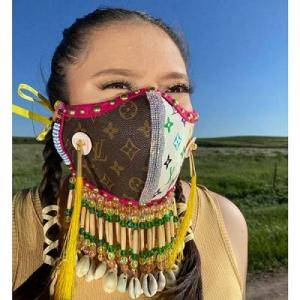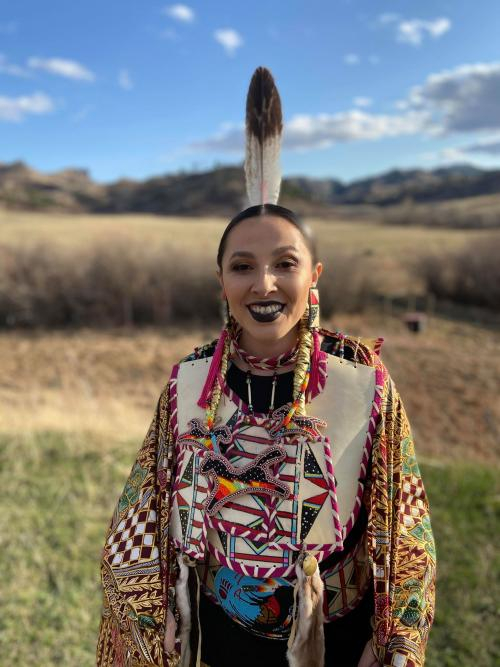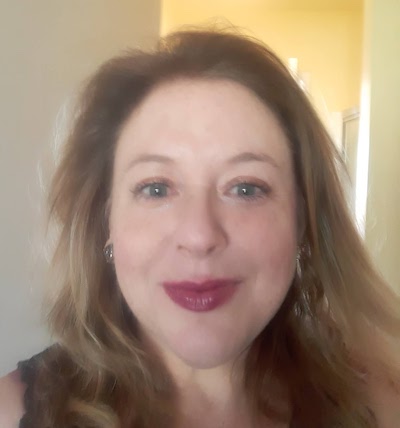
- Details
- By Tamara Ikenberg
Fashion maven Rebekah Jarvey is injecting haute couture into culturally inspired face masks.
ROCKY BOY, Mont. — Rebekah Jarvey’s handmade face mask is a loud and proud shout-out to family, friends and high fashion. The Chippewa Cree designer took advantage of her days under lockdown to weave pieces from iconic fashion brand Louis Vuitton with culturally inspired details into a unique face covering with an urban touch.
“I finally had time to put my whole self into one piece,” said Jarvey, who is also a Human Resources Generalist for her tribe in Rocky Boy, Mont.
The vibrant colors and cultural contrasts make the mask pop. Seemingly incongruent at first, the famed luxury Louis Vuitton logo, sprouting yellow horse hair, and dripping with cowrie shell and fire-polished bead fringe, makes perfect fashion sense once it all sinks in.
“I wanted to unite French fashion house Louis Vuitton and Indigenous style with a modern urban touch,” said Jarvey. “I’m a lover of fashion and I collected the Louis Vuitton purses from thrift stores a long time ago. I just wanted to up-cycle them and use them in the best way I know how.”
Many materials that Jarvey had saved up for future projects play into the mask, which she named “Night & Day.” “Most of them have a special or sentimental meaning to me,” Jarvey said. “They were also the materials I had on hand, because in April it was almost impossible to get stuff.”
Jarvey keeps her home stocked like a Native American art store that also happens to carry Louis Vuitton purses. She had everything from brass studs and cones to antique hair pipe bone and ribbon, waiting for the perfect moment to be put to use.
 Chippewa Cree designer Rebekah Jarvey in her dancing regalia. The Rocky Boy, Montana resident made the shawl. (Mark Jarvey Jr.)Jarvey also had the help of her artistic son Royce, 15.
Chippewa Cree designer Rebekah Jarvey in her dancing regalia. The Rocky Boy, Montana resident made the shawl. (Mark Jarvey Jr.)Jarvey also had the help of her artistic son Royce, 15.
“It was his vision to use two different colored halves, ,” she said. For his part, Royce helped bead the vertical ropes framing the mask.
“I’m proud to say he’s a fifth-generation beader,” Jarvey said. “I’m a fourth-generation beader and sewer on my matriarch’s side, so I’m carrying on the tradition in teaching my son.“
The seed beads Jarvey and Royce used in the mask were gifted to them a couple of years ago by friends from the Czech Republic.
“I remember that good feeling that they had when they were so happy to give me those beads from their homeland,” Jarvey said. “I put that feeling into the mask when we beaded it and I told my son and significant other the story of how I got those beads.”
“Night & Day,” is strictly an art piece, though Jarvey has also designed a number of protective masks for everyday use since the pandemic started.
“We went on lockdown March 14, and there was a call to make masks,” Jarvey said. “The first mask I made was in the last week of March. I made it for myself just to see if I did it right, and I made more for my family, and it just went from there.”
Jarvey is part of a growing virtual network of Native American artists using the pandemic as an opportunity to channel their creative energy into mask making, while incorporating traditional craftsmanship.
She submitted “Night & Day” to Facebook’s Breathe. group, a community of almost 2,000 Indigenous artists showcasing their mask work, and she said the mask went viral through Facebook’s Social Distance Pow Wow, a virtual Native American meeting place with nearly 200,000 members.
“This way of art is a new style that is deriving and going worldwide,” Jarvey said. “It’s just amazing to see how versatile and adaptive Indigenous people are, and how everybody comes to their creativity through making a mask.”
(For more information about face masks and other designer items, contact Rebekah Jarvey at [email protected], and check out her Instagram @rebekah.jarvey)
More Stories Like This
Native News Weekly (August 25, 2024): D.C. BriefsUS Presidents in Their Own Words Concerning American Indians
Native News Weekly (December 21, 2025): D.C. Briefs
Native America Celebrates the Winter Solstice
Tlingit & Haida Launch New Foundation to Support Education, Wellness
Help us defend tribal sovereignty.
At Native News Online, our mission is rooted in telling the stories that strengthen sovereignty and uplift Indigenous voices — not just at year’s end, but every single day.
Because of your generosity last year, we were able to keep our reporters on the ground in tribal communities, at national gatherings and in the halls of Congress — covering the issues that matter most to Indian Country: sovereignty, culture, education, health and economic opportunity.
That support sustained us through a tough year in 2025. Now, as we look to the year ahead, we need your help right now to ensure warrior journalism remains strong — reporting that defends tribal sovereignty, amplifies Native truth, and holds power accountable.
 The stakes couldn't be higher. Your support keeps Native voices heard, Native stories told and Native sovereignty defended.
The stakes couldn't be higher. Your support keeps Native voices heard, Native stories told and Native sovereignty defended.
Stand with Warrior Journalism today.
Levi Rickert (Potawatomi), Editor & Publisher

